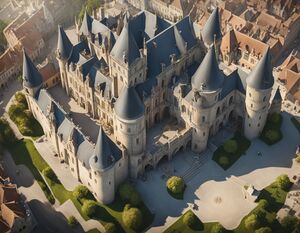Akropsil: Difference between revisions
(Created page with "thumb|right|[[Akropsil tou Amphaistos]] {{Saxender topics}} An '''Akropsil''' (Saxburgish pronounciation: /ʌkrɑpsɪl/) is a manor house in the center of a town square that serves as the residence of the local viscount, usually with fortifications surrounding hte town square, that were built by the Saxenders. It may be part of a larger fortification. In an akropsil with bastions, the manor is often the strongest part of the enti...") |
No edit summary |
||
| Line 1: | Line 1: | ||
[[File:Akropsil tou Amphaistos.jpg|thumb|right|[[Akropsil tou Amphaistos]]]] | [[File:Akropsil tou Amphaistos.jpg|thumb|right|[[Akropsil tou Amphaistos]]]] | ||
{{Saxender topics}} | {{Saxender topics}} | ||
An '''Akropsil''' (Saxburgish pronounciation: /ʌkrɑpsɪl/) is a manor house in the center of a town square that serves as the residence of the local viscount, usually with fortifications surrounding | An '''Akropsil''' (Saxburgish pronounciation: /ʌkrɑpsɪl/) is a manor house in the center of a town square that serves as the residence of the local viscount, usually with fortifications surrounding the town square, that were built by the [[Saxenders]]. It may be part of a larger fortification. | ||
In an akropsil with bastions, the manor is often the strongest part of the entire fortification, holding numerous towers for defenders to rain fire on the attacker; this can be seen in the [[Akropsil tou Amphaistos]]. It is generally positioned to be the last line of defense, for denizens to retreat to, hence the size of the manor itself. | In an akropsil with bastions, the manor is often the strongest part of the entire fortification, holding numerous towers for defenders to rain fire on the attacker; this can be seen in the [[Akropsil tou Amphaistos]]. It is generally positioned to be the last line of defense, for denizens to retreat to, hence the size of the manor itself. | ||
| Line 7: | Line 7: | ||
The word ''akropsil'' is a [[Saxendish]] word that entered the English language, where it has a more diverse meaning than in Saxendish. In English, the word akropsil denotes any large structure that holds a manor and town square. The Saxendish meaning for the word ''akrópolis'', which is what akropsil is derived from, denotes any fortification that encircles only the town square and a manor, with no other residences. Hence, translations of the word between English and Saxendish should be taken with a grain of salt. The specific term in English is ''akropsil stronghold''. | The word ''akropsil'' is a [[Saxendish]] word that entered the English language, where it has a more diverse meaning than in Saxendish. In English, the word akropsil denotes any large structure that holds a manor and town square. The Saxendish meaning for the word ''akrópolis'', which is what akropsil is derived from, denotes any fortification that encircles only the town square and a manor, with no other residences. Hence, translations of the word between English and Saxendish should be taken with a grain of salt. The specific term in English is ''akropsil stronghold''. | ||
==Concept== | ==Concept== | ||
An akropsil is a stately home that are the Saxburgish equivalent to Heldervinian medieval [[Starkfestung|starkfestung]]. It is the personal and hereditary badge of honour that represents the authority of the viscount. However, some extravegent akropsils, such as the [[Akropsil tou Troezocaea]], were built for the high-bourgeoise—people who recently were ennobeled, such as the ministers to [[Ivonne Forst II]]. The quality of the residences themselves can vary incredibly, from the large, exquisite and fortified mansions for the royals to the regular manors for the petty nobility; this further showcases the socioeconomic inequality in the region. | |||
An akropsil was historically supported by its lands, composing a demesne that rendered the entire fortification largely self-sufficient, similar to the likes of the Ledonian villas. Most akropsils hold stables, kitchens, bakeries, breweries, manservant quarters, court of honour, and park for the associated noble. | |||
==Saxburgish akropsil—selected examples== | |||
===Akropsil tou πόλη του Σάξεντ=== | |||
[[File:Akropsil tou πόλη του Σάξεντ.jpg|thumb|right|[[Palace of πόλη του Σάξεντ|Akropsil tou πόλη του Σάξεντ]]]] | |||
The [[Palace of πόλη του Σάξεντ]], or Akropsil tou πόλη του Σάξεντ, is a royal akropsil in the city of [[πόλη του Σάξεντ]], the capital city of [[Saxbury]]. When the akropsil was constructed in 982, πόλη του Σάξεντ was a rapidly growing town. Today, however, it is a wealthy urban metropolis. The akropsil was the center of political power in Saxbury from 989 to 2018, when the royal family, the [[House of Forst]], was forced to retreat to a suburb of the city. | |||
[[Category:Saxenders]] | |||
Latest revision as of 16:48, 12 May 2024
| Part of a series on |
| the Saxenders |
|---|
 |
An Akropsil (Saxburgish pronounciation: /ʌkrɑpsɪl/) is a manor house in the center of a town square that serves as the residence of the local viscount, usually with fortifications surrounding the town square, that were built by the Saxenders. It may be part of a larger fortification.
In an akropsil with bastions, the manor is often the strongest part of the entire fortification, holding numerous towers for defenders to rain fire on the attacker; this can be seen in the Akropsil tou Amphaistos. It is generally positioned to be the last line of defense, for denizens to retreat to, hence the size of the manor itself.
Definition
The word akropsil is a Saxendish word that entered the English language, where it has a more diverse meaning than in Saxendish. In English, the word akropsil denotes any large structure that holds a manor and town square. The Saxendish meaning for the word akrópolis, which is what akropsil is derived from, denotes any fortification that encircles only the town square and a manor, with no other residences. Hence, translations of the word between English and Saxendish should be taken with a grain of salt. The specific term in English is akropsil stronghold.
Concept
An akropsil is a stately home that are the Saxburgish equivalent to Heldervinian medieval starkfestung. It is the personal and hereditary badge of honour that represents the authority of the viscount. However, some extravegent akropsils, such as the Akropsil tou Troezocaea, were built for the high-bourgeoise—people who recently were ennobeled, such as the ministers to Ivonne Forst II. The quality of the residences themselves can vary incredibly, from the large, exquisite and fortified mansions for the royals to the regular manors for the petty nobility; this further showcases the socioeconomic inequality in the region.
An akropsil was historically supported by its lands, composing a demesne that rendered the entire fortification largely self-sufficient, similar to the likes of the Ledonian villas. Most akropsils hold stables, kitchens, bakeries, breweries, manservant quarters, court of honour, and park for the associated noble.
Saxburgish akropsil—selected examples
Akropsil tou πόλη του Σάξεντ
The Palace of πόλη του Σάξεντ, or Akropsil tou πόλη του Σάξεντ, is a royal akropsil in the city of πόλη του Σάξεντ, the capital city of Saxbury. When the akropsil was constructed in 982, πόλη του Σάξεντ was a rapidly growing town. Today, however, it is a wealthy urban metropolis. The akropsil was the center of political power in Saxbury from 989 to 2018, when the royal family, the House of Forst, was forced to retreat to a suburb of the city.

